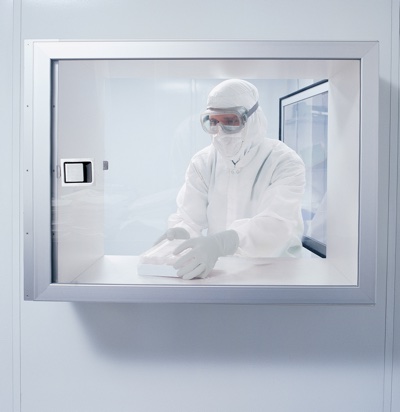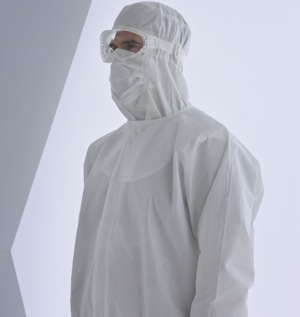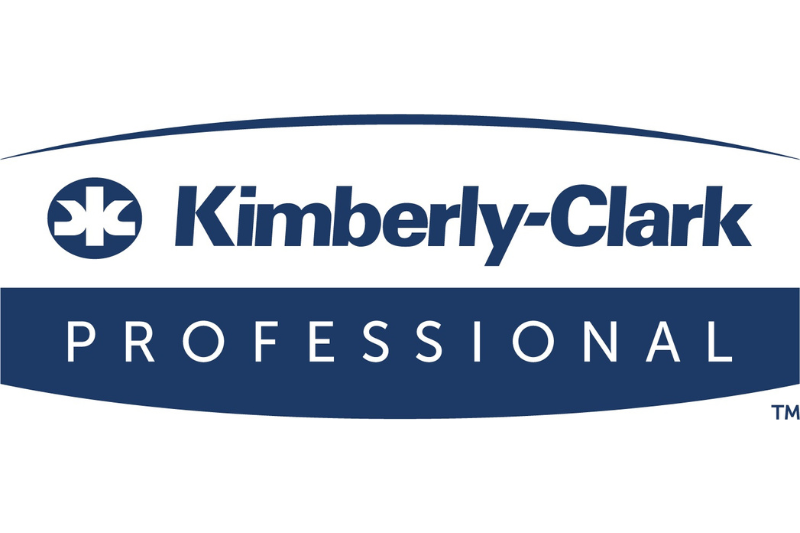Studies show that the behaviour and preparation of personnel is responsible for a large proportion of contamination issues in cleanrooms. Human error is responsible for over 80% of process deviations in pharmaceutical manufacturing environments1. Such contamination issues come in many forms. For example, 30% of all microbial detections in parenteral drug manufacturing are found on the surface of operator clothing, which is regularly contaminated during complex donning procedures2.
Contamination risks from the body, undergarments or degraded garment fibres are possible when there is a gap in the barrier. Cleanroom operators are trained to minimise unnecessary movement or talking to reduce such issues, but this is a difficult challenge in even basic manual operations — there are over a billion microbes per droplet of saliva3 and thousands of shed skin particles can be ground to as small as a micron during simple movements such as walking.
The results of such contaminations are significant and lead to billions of dollars being wasted each year in write-offs, shutdowns and lost productivity4. In 2012 nearly a third of the US sterile injectable drug industry’s manufacturing capacity was off-line due to quality issues, according to a Congressional report5, with knock-on effects on patient safety worldwide. It is time the industry implemented more effective approaches to mitigate contamination.

Design over training
In the majority of cases further training is often prescribed when human error is identified as the cause of a contamination event or GMP deviation1, possibly along with removing the operator until they are re-qualified in aseptic gowning. Such training can take up a significant amount of time and resources, with an average site spending over six hours a week performing ongoing aseptic gowning training, adding up to thousands of hours across the industry2.
However, studies have shown that training is responsible for less than 10% of the deviations related to performance1. Therefore, although training can reduce the risk of human error during gowning, alternative solutions for reducing contamination associated with people may produce better results without affecting productivity to the same extent.
One such solution is better garment design. Cleanroom apparel with a more intuitive folding and donning mechanism between areas such as the coverall, hood and over boot, along with an optimised donning process can reduce both contamination risk and the potential for human error. Real-time observation of personnel gowning techniques are required during GMP inspections6; a clear sign that it is a critical point to consider when selecting a preferred cleanroom apparel solution.
Better design can also lead to an increase in cleanroom productivity; reducing the time it takes to perform compliant aseptic gowning by just two minutes can free up over a thousand hours a year7, as well as lead to a reduction in training time. In addition, better design results in more comfortable cleanroom clothing, which has been shown to result in fewer operator errors8.
Protect processes and people
Although better designed cleanroom gowns results in fewer gaps between individual garments through which contamination may pass, microscopic damage of fabric can also cause contamination events. Such decline in the barrier occurs over time due to damage and through regular usage cycles of wearing/washing/sterilisation9.

Fully gowned cleanroom operator in Kimtech* A5 Apparel
Kimberly-Clark Professional has found that this decline in barrier performance occurs more often in reusable clothing than in single-use alternatives when single-use coveralls are assessed against laundered garments by measuring their bacterial filtration efficiency (BFE). BFE is a common measure of filtration efficiency that can be correlated to contamination risk and takes into account the actual wear and tear of garments in the cleanroom.
In addition, a recent public study has started to provide guidance on how to consider the decline of performance throughout the lifetime of a reusable garment10. Of course, the selection criteria may vary upon specific needs but the single-use solution removes variability, ensuring consistent performance every time.
Disposable cleanroom garments can also be more cost-effective. The Mcllvaine report11 shows that disposable clothing can have a lower ‘cost-per-use’ than reusable garments. ‘Cost-per-use’ takes into account apparel purchase price, as well as the average number of laundering cycles and laundering cost per item, per use (which are both zero for single-use garments).
When disposable cleanroom clothing’s cost-per-use is combined with the productivity increases and cost-savings resulting from reduced contamination events, it is clear that such clothing is extremely attractive from a financial standpoint. However, the cost of disposal should also be considered, and this can be minimised through effective recycling programmes.
Improved sustainability through material reuse
Ensuring garment sustainability is vital to the acceptance of disposable clothing, and requires an analysis of energy and material used throughout the product lifecycle (from manufacturing, through re-processing, to eventual disposal). Several studies on sustainability, such as the McIlvaine report11 have found that reusable cleanroom garments can have a larger overall impact on environmental resources than single-use garments, consuming up to 4.5 times more resources.
Modern materials offer new opportunities for reducing waste through recycling, such as in Kimberly-Clark Professional’s RightCycle programme. This initiative helps pharmaceutical companies to improve sustainability by collecting used apparel and gloves and upcycling them into eco-friendly products such as furniture and bike racks (that can in turn be recycled again).
The wide range of issues resulting from contamination control that have been explored in this article are multi-faceted, and require a mitigation approach that addresses all aspects of clothing use and disposal. Documented and enforced training programmes, verified ongoing adherence to the latest regulatory compliance, and effective disposal and recycling procedures can all be combined to create a safer, more productive and sustainable operation. High quality clothing design plays a vital role in this.
Kimtech A5 Sterile Cleanroom Apparel has been designed to provide this solution. The Kimtech SMS (Spunbond/ Meltblown/ Spunbond) fabric provides strength, cloth-like comfort and a strong barrier for fine particles and liquids. Its middle layer acts like a filter which traps particles while maximising airflow to keep the wearer cool and comfortable. In addition, the sterilisation process, involving gamma irradiation of the polymers, occur on only a single garment at a time, so the apparel’s protective properties are consistently maintained.
Proprietary CLEAN-DON technology ensures gowning is simple to learn and minimises contamination during the donning process2. The garments are uniquely configured with inside-out folding, and with arms and legs pre-drawn and snapped in position, reducing the risk of touching the outside of the suit2, or any other surface while gowning. In addition, the vacuum packaging is not only a way to extend the sterile validity but also acts as a visual sterility breach indicator.
By demonstrating how optimised cleanroom clothing can reduce contamination and form part of a system that produces better results at a lower cost, Kimtech aims to support continuous improvement across the pharmaceutical industry.
Well-designed disposable cleanroom garments have been shown to be cost-effective and sustainable, while also providing improved contamination protection and greater comfort for pharmaceutical cleanroom operators. Cutting down on the human causes of contamination by using disposable apparel leads to increased productivity and a reduction in operator training requirements, cleanroom downtime and drug shortages — truly assisting modern cleanrooms to dress for success!
Reference and bibliography
1. Ginette Collazo. “Reducing Human Error on the Manufacturing Floor.” MasterControl, 2010.
2. Damon Larkin. Donning by design. Cleanroom Technology, July 2010.
4. Katie Thomas. Lapses at Big Drug Factories Add to Shortages and Danger. The New York Times, 17. 10. 2012.
5. 2012 Report FDA’s Contribution to the Drug Shortage Crisis.
6. FDA Compliance program guidance manual, Nov 2015.
7. A 2 minute reduction in gowning time for a site with 100 cleanroom entries/day equates to a saving of 1,117 hrs/year (2 min/entry x 100 entries/day x 335 days/year = 67,000 mins/year = 1,117 hrs/year).
8. How our clothing affects our work, Hohenstein Institute, March 2011.
9. F. Romano, B. Ljungqvist, B. Reinmüller et al. (2016). Performance test of technical cleanroom clothing systems, Proceedings of Indoor Air 2016, 14th International Conference on Indoor Air Quality and Climate, p990, Ghent, Belgium, 2016. [Nr. 245692] http://www.isiaq.org/docs/Papers/Paper990.pdf.
10. A life cycle assessment of reusable garment properties, Cleanroom Technology, Vol 25, 6, pp15-18.
11. McIlvaine Company. A White Paper on Performance, Cost Per Use, and Environmental Impact of Single-Use and Reusable Surgical Gowns & Drapes. 2009.





